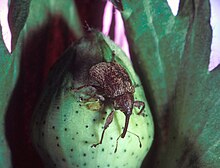グランジソール
| グランジソール | |
|---|---|

| |

| |
2-[(1R,2S)-1-Methyl-2-(prop-1-en-2-yl)cyclobutyl]ethan-1-ol | |
別称 cis-2-Isopropenyl-1-methylcyclobutaneethanol | |
| 識別情報 | |
| CAS登録番号 | 26532-22-9 |
| PubChem | 169202 |
| ChemSpider | 147990 |
| UNII | 9S44Q9MKXB |
| |
| 特性 | |
| 化学式 | C10H18O |
| モル質量 | 154.25 g/mol |
| 融点 |
25 °C, 298 K, 77 °F |
| 沸点 |
55 °C, 328 K, 131 °F |
| 特記なき場合、データは常温 (25 °C)・常圧 (100 kPa) におけるものである。 | |
グランジソール(英: Grandisol、化学式C10H18O)はワタミハナゾウムシの性誘引物質として働くフェロモンである[1]。シクロブタン環と2つの不斉中心を有するモノテルペンである。ワタミハナゾウムシは農業害虫であり、綿花産業に大きな被害を与える。20世紀前半には米国で蔓延し、深刻な問題となった。グランジソールは綿花を虫害から守るために使用される。

合成[編集]
グランジソールは1969年に、ミシシッピ州立大学のJ.Tumlinsonらによって単離、同定、合成が報告された[2]。2010年にはファーマン大学の研究グループが8段階でより収率を高めた合成経路を報告している[3] 。立体選択的な合成方法も報告されている[4]が、グランジソールはラセミ体でも、ワタミハナゾウムシに対して天然のものと同様の誘引効果を持つことが示されている[5]。
脚注[編集]
出典[編集]
- ^ 『ボルハルト・ショア―現代有機化学(上)第8版』化学同人、2019年12月20日、202頁。ISBN 978-4-7598-2029-4。
- ^ Tumlinson, J. H.; Hardee, D. D.; Gueldner, R. C.; Thompson, A. C.; Hedin, P. A.; Minyard, J. P. (1969-11-21). “Sex Pheromones Produced by Male Boll Weevil: Isolation, Identification, and Synthesis” (英語). Science 166 (3908): 1010–1012. doi:10.1126/science.166.3908.1010. ISSN 0036-8075.
- ^ Graham, Thomas J.A.; Gray, Erin E.; Burgess, James M.; Goess, Brian C. (January 2010). “An Efficient Synthesis of (±)-Grandisol Featuring 1,5-Enyne Metathesis”. J. Org. Chem. 75 (1): 226–228. doi:10.1021/jo9020375. PMC 2798917. PMID 19957923.
- ^ de March, Pedro; Figueredo, Marta; Font, Josep; Raya, Javier (2000-01-01). “Highly Efficient, Enantioselective Synthesis of (+)-Grandisol from a C 2 -Symmetric Bis(α,β-butenolide)” (英語). Organic Letters 2 (2): 163–165. doi:10.1021/ol991261k. ISSN 1523-7060.
- ^ Hibbard, B. E.; Webster, F. X. (1993-10). “Enantiomeric composition of grandisol and grandisal produced byPissodes strobi andP. nemorensis and their electroantennogram response to pure enantiomers” (英語). Journal of Chemical Ecology 19 (10): 2129–2141. doi:10.1007/BF00979652. ISSN 0098-0331.
